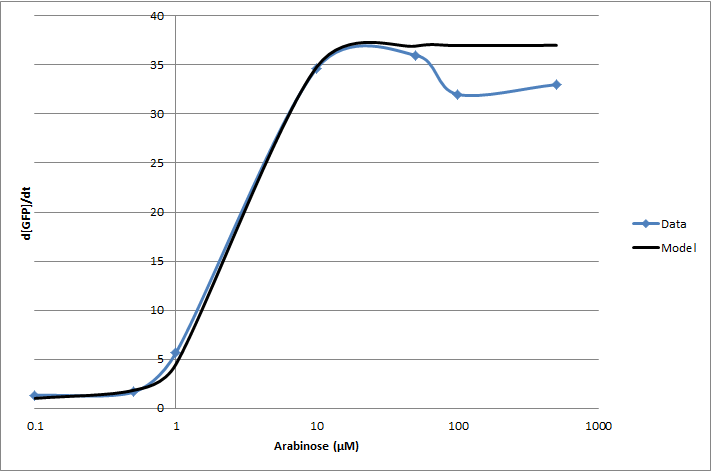Difference between revisions of "Part:BBa I13453"
m |
|||
| Line 11: | Line 11: | ||
See this OpenWetWare article on [http://openwetware.org/wiki/Titratable_control_of_pBAD_and_lac_promoters_in_individual_E._coli_cells#pBAD_promotersOpenWetWare pBAD and lac promoters] for additional usage and biology information | See this OpenWetWare article on [http://openwetware.org/wiki/Titratable_control_of_pBAD_and_lac_promoters_in_individual_E._coli_cells#pBAD_promotersOpenWetWare pBAD and lac promoters] for additional usage and biology information | ||
| − | + | ||
| − | + | ||
<span class='h3bb'>Sequence and Features</span> | <span class='h3bb'>Sequence and Features</span> | ||
<partinfo>BBa_I13453 SequenceAndFeatures</partinfo> | <partinfo>BBa_I13453 SequenceAndFeatures</partinfo> | ||
| + | ===Characterization=== | ||
| + | For the 2009 iGEM competition, British_Columbia characterized <partinfo>I13453</partinfo> in the context of a [https://parts.igem.org/PBAD_Promoter_Family pBAD promoter family]. For the results of this characterization, see [[Part:BBa_I13453:British_Columbia|here]]. | ||
| + | |||
| + | For the 2010 iGEM competition, Tec-Monterrey characterized <partinfo>I13453</partinfo> again, using a construct of GFP reporter after the pBad promoter. The transfer function was modeled with a Hill equation. | ||
| + | <!-- --> | ||
| + | [[Image:pbadwt.png|center|frame|Figure 1. Transfer function of <partinfo>BBa_I13453</partinfo>. Points represent individual measurements. The line is of a Hill equation fitted to our data.]] | ||
| + | <center> | ||
| + | (d[GFP]/dt)/OD<sub>600</sub> = C+A*X<sup>n</sup>/(X<sup>n</sup>+K<sup>n</sup>) | ||
| + | {|{{Table}} | ||
| + | !Experiment | ||
| + | !Characteristic | ||
| + | !Value | ||
| + | |- | ||
| + | |rowspan="4"|[[#Transfer Function|'''Transfer Function''']] | ||
| + | |''Basal rate (C)'' | ||
| + | |1 d[GFP]/dt | ||
| + | |- | ||
| + | |''Gain (A)'' | ||
| + | |36 d[GFP]/dt | ||
| + | |- | ||
| + | |''Hill coefficient (n)'' | ||
| + | |2.16 | ||
| + | |- | ||
| + | |''Switch Point (K)'' | ||
| + | |2.8 [ara] (µM) | ||
| + | |||
| + | |- | ||
| + | |} | ||
| + | </center> | ||
<!-- Uncomment this to enable Functional Parameter display | <!-- Uncomment this to enable Functional Parameter display | ||
Revision as of 11:45, 27 October 2010
Pbad promoter
PBad promoter from I0500 without AraC.
Usage and Biology
Has been used as a second promoter in a system containing BBa_I0500 (PBad+AraC). In this system, it showed behavior qualitatively indistinguishable from the BBa_I0500 copy of PBad. Has not been tested independent of AraC. A second part, BBa_I13458, should allow decoupling of PBad and AraC.
See this OpenWetWare article on [http://openwetware.org/wiki/Titratable_control_of_pBAD_and_lac_promoters_in_individual_E._coli_cells#pBAD_promotersOpenWetWare pBAD and lac promoters] for additional usage and biology information
Sequence and Features
- 10COMPATIBLE WITH RFC[10]
- 12INCOMPATIBLE WITH RFC[12]Illegal NheI site found at 125
- 21INCOMPATIBLE WITH RFC[21]Illegal BamHI site found at 65
- 23COMPATIBLE WITH RFC[23]
- 25COMPATIBLE WITH RFC[25]
- 1000COMPATIBLE WITH RFC[1000]
Characterization
For the 2009 iGEM competition, British_Columbia characterized BBa_I13453 in the context of a pBAD promoter family. For the results of this characterization, see here.
For the 2010 iGEM competition, Tec-Monterrey characterized BBa_I13453 again, using a construct of GFP reporter after the pBad promoter. The transfer function was modeled with a Hill equation.

(d[GFP]/dt)/OD600 = C+A*Xn/(Xn+Kn)
| Experiment | Characteristic | Value |
|---|---|---|
| Transfer Function | Basal rate (C) | 1 d[GFP]/dt |
| Gain (A) | 36 d[GFP]/dt | |
| Hill coefficient (n) | 2.16 | |
| Switch Point (K) | 2.8 [ara] (µM) |
